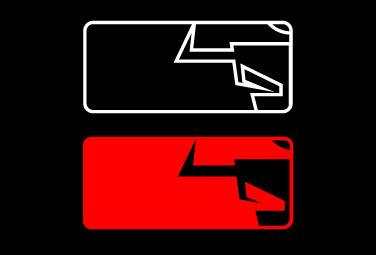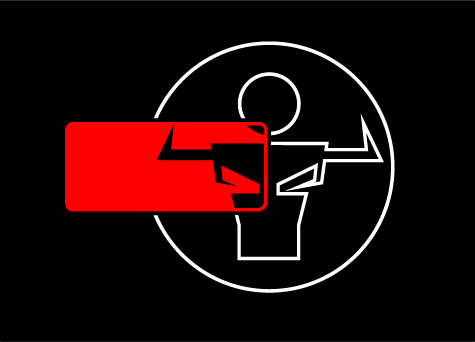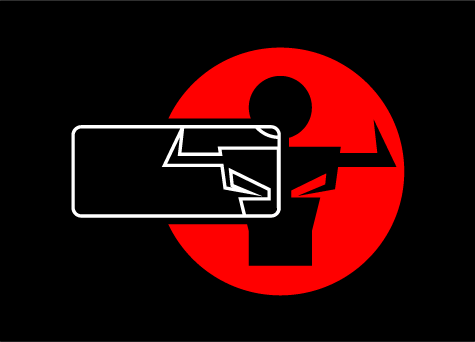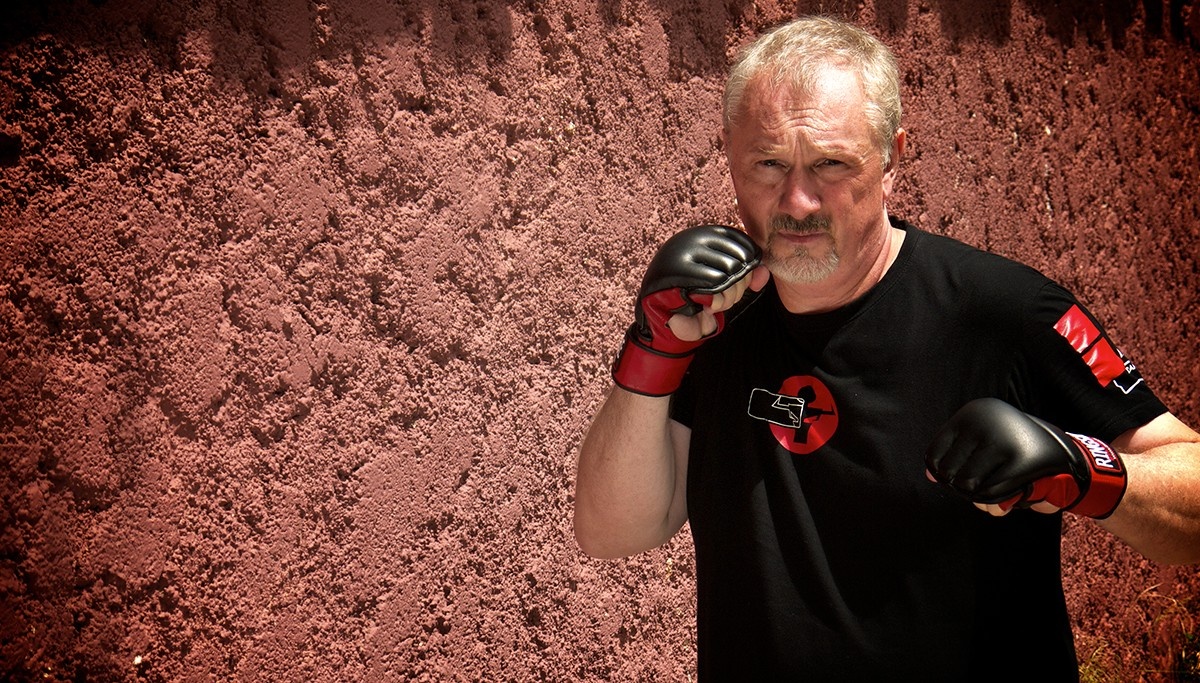

LOGO HISTORY
I created my first logo of "The Bull" in 1992 for the Second Modern Arnis Summercamp in Lübeck, Germany. The inspiration behind the Bull comes from the Majapahit Empire. In 1993 the second version was made by one of my students, Guillaume Boube. At that time the Logo was associated with the name of my French Association, MMA (Majapahit Martial Arts). This version of my logo was trademarked in 1995 as MMA.
I designed my third version of "The Bull" in 1995 under MMA. In 1998 I changed the name from MMA to IKSA (International Kali Sikaran Association) for the release of my first Kali Sikaran Program. I carried that logo from 1995 to 2010. This version of the logo has been carried worldwide since 2000 and is still in use today. This logo was trademarked in 2002 as IKSA, then again trademarked in 2006 as Kali Sikaran in association with my IKAEF logo.
In 2010 I felt the need to move on, to write a new chapter. I redesigned my logo for the fourth time. I released the full version in 2014 for my students, who have attained the ranking of Guro or 5th Dan and up. This logo has been part of who I am for more then 30 years…
In 2016, "The Bull" follow me in my new approach as the KSE logo… Why keep the same logo after all these years... Simple, It took me more then 30 years to find the philosophy that goes with...
THE ORIGINAL MEANING
The Kali Sikaran logo is influenced by the History of the Southeast Asia, especially the Majapahit Empire from1293 to 1500. Majapahit was an Empire consisting of 98 tributaries, stretching from Sumatra to New Guinea. Majapahit was one of the last major empires of the region and is considered to be one of the greatest and most powerful Empires in the history of the region, today known as Indonesia.
Legends say the Majapahit Empire base on the island of Java hosted their best fighters from all over Middle East Asia, Bali, Burma, Malaysia, Thailand and the Philippines. All came with their own styles. Kali for the Filipinos, Muay Boran and Krabi Krabong for the Thais, Pencak Silat for the Indonesians and Malaysians.
The Bull was a symbol of strength and power in the Majapahit. We take the symbol of the Majapahit Empire as a link between the Arts of Kali, Muay Boran and Pencak Silat. The logo has been redesign to fit our Concept and Philosophy. We use this Bull to represent the base of our style, a true balance between strength and power, between body and mind. The circle above our Bull logo is symbolic of spiritual strength and a higher understanding.


The rectangle is the foundation of the KSE logo, which represents our KSE Curriculum. This is what I share with all of you. This is our common language.
Empty Logo... So many things to discover.
Red Logo... Applying what you have learned.

The logo for the Guro's is in two parts. The rectangle is a part of what we do, however it is up to you to find yourself. The rectangle is the base, that you use to find your own path, this is our common language.
Therefore, the circle around represents, who you become throughout the years. I don't want the KSE Curriculum to be a dogma, but to be the beginning of your own freedom. Your own path.

The Dakilang logo... The rectangle is just a part of who I am. This is what I share, not who I am. I refuse to limit myself to my own Curriculum. The emptiness of color in the rectangle is to remind me that I should always be looking for new ways to teach and share. There are so many things that I still have to learn, so much yet to discover. The color of the full circle is the symbol of my current knowledge, not yet complete and still growing. As a founder I should never be completely satisfied. I believe we should always try to move forward. But it also means that I know exactly how much I can bleed when it comes the time to apply. This logo represents my state of mind.
" I just want to enjoy my Art, not knowing where it will lead me. These are the KSE values. "


DAKILANG GURO JEFF " THE BULL " ESPINOUS
Dakilang Guro Jeff Espinous was born in 1963 in Paris, France. He started training Martial Arts in 1968 with Wrestling then in 1970 in Viet Vo Dao. Since then he has been certified in several Martial Arts Styles including Boxe Francaise Savate, Kick Boxing, Tae Kwon Do, Viet Vo Dao, Ju Jutsu, Kempo, Ken Ju Ryu, Muay Thai, Kali / JKD, and some different styles of FMA and Pencak Silat.
He was introduced to FMA in 1983 in Paris, France during the first seminar of Dan Inosanto. From 1985 to 1989 he moved to Los Angeles, US to train at the “Inosanto Academy“ with Dan Inosanto, Cass Magda, Paul De Thouars, Herman Suwanda, Larry Hartsell and Ted Lucaylucay. Punong Guro Espinous also trained with Ted Lucaylucay at the “Temujin“ in Bakersfield, US. During this period he frequently traveled to South East Asia to train in Filipino Martial Arts, Pencak Silat and Muay Boran.
In 1989, he started teaching Filipino Martial Arts in Paris and was the first Instructor dedicated to teaching FMA in France. At that time he taught under the Lucaylucay Kali / JKD Association from Guro Ted Lucaylucay.
In 1992, he created his own Style, Kali Sikaran and designed his first logo “the Bull“. In 1993, he named his first Association MMA (Majapahit Martial Arts) and redesigned of the Kali Sikaran logo was made by Guillaume Boube.
In March 1993, during the first European Stick Fighting Championship in London, England the EKAEF (European Kali Arnis Eskrima Federation) was created. Seven Nations were represented Denmark, England, France, Finland, Germany Italy, and Sweden. The Headquarter elected Bobby Breen as President and Jeff Espinous as Vice-President.
In December 1994, after training with Mangisurosuro Mike Inay Founder of the Inayan Eskrima, Guro Jeff held the position of European Technical Director for the Inayan Eskrima from 1994 until his death in 2000. He promoted the seminar tour of the late Mangisurosuro Mike Inay in Europe and certified and promoted Inayan Instructors in Europe his supervision.
In June 1995, during the second European Stick Fighting Championship in Paris, France. He was promoted President of the EKAEF and became the European Technical Director from 1995 to 2000. In July 1995, Then he created the IKSA (International Kali Sikaran Association) to further promote the Art of Kali Sikaran around the world and redesigned his logo for the third time. At this time he stopped using the name MMA and rebranded it into IKSA (International Kali Sikaran Association). He is the IKSA International Technical Director since 1995.
In June 1996, Jeff was promoted as Director of WEKAF France (World Eskrima Kali Arnis Federation) from 1996 to 1998. In July 1998, he released the first Kali Sikaran Program. Updated versions were released in 2000 and 2004.
In July 1998, during the Bundesseminar he received the rank of 5° Dan in Ju-Jutsu under DJJV (Deutscher Ju Jutsu Verband).
In November 2000, the Headquarters decided to change the name EKAEF to IKAEF (International Kali Arnis Eskrima Federation) to further promote the FMA around the world. He has held the position of IKAEF International Technical Director since 2000.
Through the years Jeff has designed logos for the FMA World. Suntukan Stickfighting for Guro Johan Skålberg. Cinco Tero Escrima for Guro Charles & Walter Goossens. Inayan Martial Arts from Guro Jon C. Ward. Kali Self Defence for Richard Haye to name some…
In December 2000, Jeff Espinous and Johan Skålberg formed a partnership to join their efforts in promoting Kali Sikaran. At that time they carry the ranks given by Suro Mike Inay. Masirib Guro for Jeff Espinous and Lahong Guro for Johan Skålberg.
August 2004, Jeff took the title of Punong Guro as advised by the late Suro Mike Inay before he passed away and gave the same title to his partner Johan Skålberg.
In 2006, Jeff was promote by Pendekar Utama Joko Suseno has Pendekar Muda in Pencak Silat Tapac Suci.
In 2007, Jeff became the “Co-Founder“ of the Pencak Silat Rampai with Pendekar Mangalla Joko Suseno and holds the title of Pendekar Wijaya in Pencak Silat Rampai. They collaborated to create the Pencak Silat Rampai or Pencak Silat Concept Program.
In 2008, Jeff and his partner Johan Skålberg decided to work on their own. Today, Punong Guro Johan Skålberg still promotes his own version of Kali Sikaran under KSI.
In 2010, Jeff redesigned his Kali Sikaran logo for the fourth time. He released in 2012 his first digital versions of the Kali Sikaran Program. It now contains the program in written and in video form.
In 2014, after 45 years of Martial Arts and 30 years of FMA, Jeff has been promoted to Dakilang Guro and as the Creator of the Kali Sikaran…
During the same year, he has the privilege to received the rank of Kyoshi, Master 7° Dan in Ken Ju Ryu / Kenpo Ju Jitsu from Hanshi Russ Rhodes from the Pacific Coast Martial arts Association.
In July 2016, Dakilang Guro Jeff Espinous rebranded his style as Kali Silat Evolution or KSE. And work in his new KSE Curriculum.
In March 2022, he has received the rank of 7° Dan in Kick Boxing from Brad Fowler and the IKF / International Kick Boxing Federation and Fowler's Strike Force.
Some of the notable Filipino Martial Arts Instructors Dakilang Guro Espinous has had the privilege to train and work with include:
- Bobby Breen / Kali JKD / 4D Combat
- Richard Bustillo ⁺ / Cacoy Doce Pares / Lee Jun Fan / JKD
- Cacoy Cañete ⁺ / Cacoy Doces Pares
- Brad Fowler / Boxing / Kick Boxing
- Krishna Godhania / Warrior Eskrima
- Emanuel Hart / Inayan System Of Eskrima
- Larry Hartsell ⁺ / Jun Fan Jeet Kune Do Grappling
- Mike Inay ⁺ / Inayan System Of Eskrima
- Dan Inosanto / Inosanto Kali / Maphilindo Silat / JKD
- Dieter Knüttel / Modern Arnis
- Ted Lucaylucay ⁺ / Lucaylucay Kali JKD
- Cass Magda / Inosanto Kali / Maphilindo Silat / JKD
- Russ Rhodes / Ken Ju Ryu / Kempo Ju Jitsu
- Jack Santos ⁺ / Balintawak
- Johan Skålberg / Modern Arnis / Kombatan
- Jon C. Ward / Inayan System Of Eskrima
Some of the notable Pencak Silat Instructors Dakilang Guro Espinous has had the privilege to train and work with include:
- Paul De Thouars ⁺ / Pencak Silat Bukti Negara
- Dan Inosanto / Inosanto Kali / Maphilindo Silat / JKD
- M. Barie Irsjad ⁺ / Pencak Silat Tapak Suci
- Cass Magda / Inosanto Kali / Maphilindo Silat / JKD
- Haryadi Mawardi ⁺ / Pencak Silat Tapak Suci
- Pak ⁺ / Pencak Silat Pukulan Madura
- Joko Suseno / Pencak Silat Tapak Suci
- Herman Suwanda ⁺ / Pencak Silat Mande Muda
Some of the notable Martial Arts Instructors Dakilang Guro Espinous has had the privilege to train and work with include:
- Salem Assli ⁺ / Boxe Francaise / Savate / Kali / JKD
- Didier Aubry / Tae Kwon Do
- Brad Fowler / Boxing / Kick Boxing
- Ho ⁺ / Viet Vo Dao
- Lee Kwon Young / Tae Kwon Do
- Roger Lafond ⁺ / Savate / Canne / Baton / Panache
- Russ Rhodes / Ken Ju Ryu / Kempo Ju Jitsu
- Skou ⁺ / Muay Thai / Muay Boran / Krabi Krabong
In Filipino Martial Arts Dakilang Guro is certified in following styles:
- Lucaylucay Kali . JKD / LKJKDA - Instructor Monitor - 1989
- Modern Arnis / IPMAAF - 1 Dan - 1992
- Kali Sikaran / IKSA - Founder - 1992
- Filipino Martial Arts / EKAEF - Guro - 1994
- Inayan Sinawali / ITO - Instructor - 1995
- Inayan Dequerdas / ITO Instructor - 1996
- Inayan Kadena De Mano / ITO - Instructor - 1997
- Inayan Largo Mano / ITO - Instructor - 1998
- Kali Sikaran / IKSA - Founder - Punong Guro - 2004
- Kali Silat Evolution / KSE - Founder - Dakilang Guro - 2016
In addition to the Filipino Martial Arts Dakilang Guro Jeff Espinous is certified in following styles:
- Viet Vo Dao / VVDA - 2˚ Dan - 1980
- Boxe Francaise Savate / FFBFS - Silver Gloves - 1987
- Tae Kwon Do / FFKAMA - 2 ˚ Dan - 1989
- Kick Boxing / BKO - 5 ˚ Dan - 1990
- Kempo / BKO - 3 ˚ Dan - 1990
- Muay Thai / IFMA - Kru - 1995
- Tae Kwon Do / WCMA - 4 ˚ Dan - 1998
- Hapkido / WCHF - 3 ˚ Dan - 1998
- Ju Jutsu / DJJV - 5 ˚ Dan - 1998
- Pencak Silat Tapac Suci / PSBI - Pendekar Muda - 2006
- Pencak Silat Rampai / PSC - Pendekar Wijaya - 2007
- Ken Ju Ryu / Kempo Ju Jitsu / PCAMA - Kyoshi 7 ˚ Dan - 2014
- Kick Boxing / IKF . FSF - 7 ˚ Dan - 2022
“ I’m thankful to all the Masters who have influenced me. They have touched me as a Martial Artist but also as a Human being. I will never forget what they gave to me… “
Dakilang Guro Jeff Espinous

